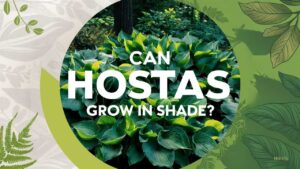In this guide, we’ll explore remarkable native evergreens, each brimming with unique characteristics and benefits.
California Bay (Umbellularia californica)
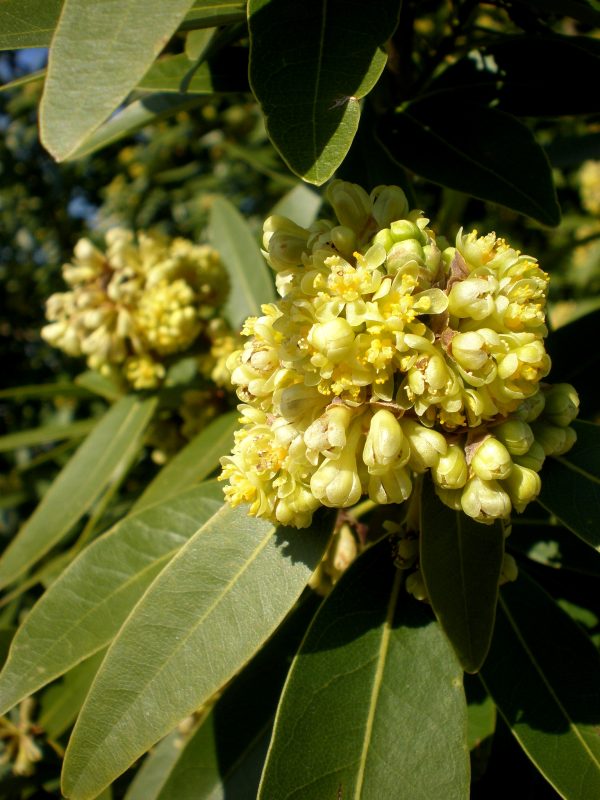
California Bay is a remarkable evergreen tree found predominantly along the Pacific Coast, stretching from the redwood forests of California down to the northern regions of Baja California. Esteemed for its aromatic, leathery leaves, this tree is not just aesthetically pleasing but functional, too. The leaves, rich in essential oils, produce a delightful fragrance reminiscent of both bay leaves and spice, making them a coveted ingredient among chefs and herbalists alike.
California Bay thrives in coastal and forested areas, often forming a part of mixed evergreen forests. Its dense canopy provides essential shelter and habitat for various wildlife, including birds, small mammals, and insects. Beyond its culinary applications, the wood of the California Bay is prized for its durability and appealing grain, making it a favorite in crafting and woodworking.
Importantly, California Bay also plays a significant role in traditional medicine among indigenous communities. It is used in herbal remedies for different ailments, celebrating a connection to the land that stretches back centuries. Planting California Bay not only enhances our landscapes but helps maintain the biological and cultural heritage of the region.
Carolina Rhododendron (Rhododendron macrophyllum)
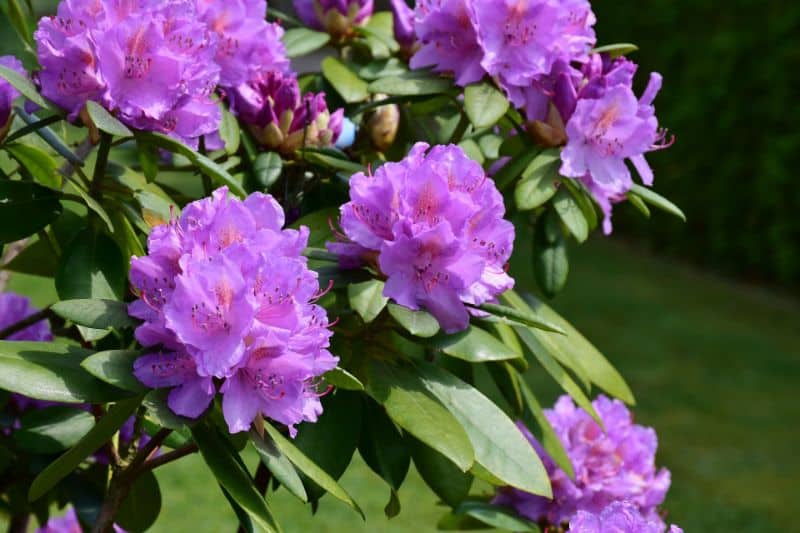
A true gem of the southeastern United States, the Carolina Rhododendron is cherished for its stunning blossoms and lush foliage. These native evergreens bloom in late spring, showcasing vibrant clusters of pink to lavender flowers that attract pollinators, such as bees and butterflies. The leaves are large and broad, glossy in appearance, providing a striking contrast to the stunning blooms.
This shrub prefers the acidic soils of mountainous regions and thrives in partial shade, making it an ideal addition to woodland gardens or shaded areas. Its deep root system promotes soil stability, helping prevent erosion on steep slopes. The Carolina Rhododendron is more than just a pretty face; it also serves vital functions in its ecosystem.
Integration of the Carolina Rhododendron into landscape design can mimic its natural habitat, creating a haven for wildlife and enhancing biodiversity. Additionally, its evergreen nature ensures that even in the depths of winter, a sense of life remains in your garden, offering visual interest during the colder months.
Creeping Blueberry (Vaccinium darrowii)
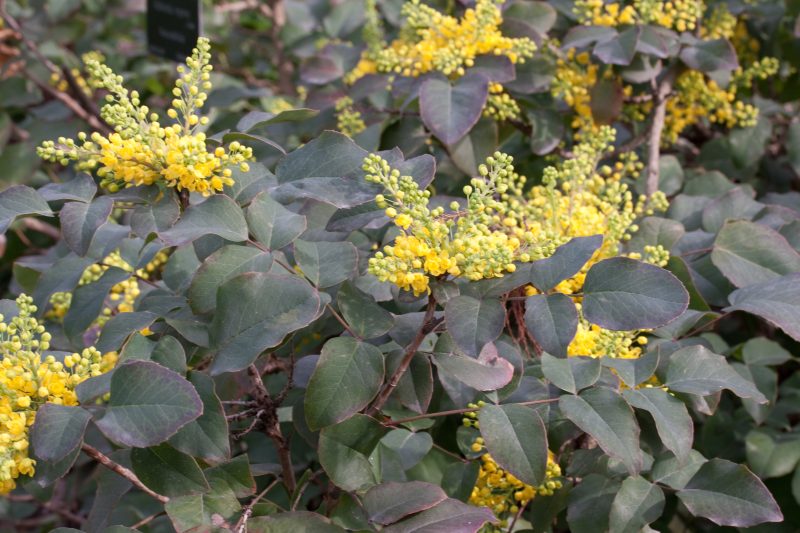
Creeping Blueberry is a low-growing, hardy shrub that can mold itself into the contours of the land, forming a dense carpet of green and an abundance of delicious fruits. Native to the southeastern United States, this evergreen gem is particularly famous for its sweet, tart blueberries. These berries not only tantalize the taste buds but also attract a plethora of birds and other wildlife, enriching the local ecosystem.
This plant flourishes in well-drained, acidic soils and is well-suited for both dry and boggy conditions, making it a versatile choice for a variety of garden landscapes. The glossy, dark green foliage provides year-round interest, and during the blooming season, delicate white flowers grace the branches, adding charm to any garden.
Creeping Blueberry is an excellent choice for edible landscaping, allowing gardeners to enjoy fresh berries while supporting native plant biodiversity. It’s also a fantastic example of how native plants can beautifully coexist with traditional garden plants, offering not only visual appeal but essential ecological benefits.
Dwarf Palmetto (Sabal minor)
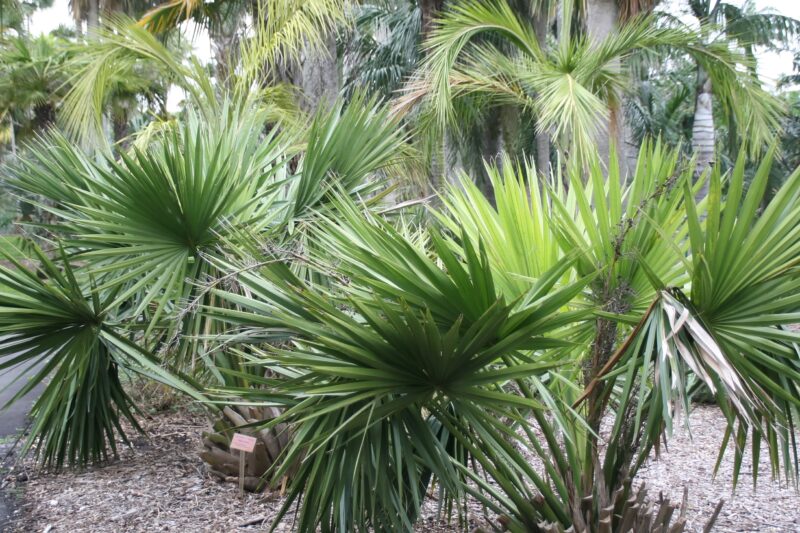
For those seeking a unique element in their garden, the Dwarf Palmetto stands out with its distinctive fan-shaped fronds and compact growth habit. Native to the Southeastern United States, this resilient palm is well-adapted to various soil types and tolerates both wet and dry conditions, making it a versatile choice for diverse landscapes.
Dwarf Palmetto typically grows in clumps, forming a low, broad mound that provides shelter for countless small creatures. Its sturdy leaves provide excellent protection from harsh winds, further cementing its role in local ecosystems. The flowers, which appear in late spring, attract bees and other pollinators, playing a crucial part in the food web.
In addition to its ecological values, the Dwarf Palmetto is aesthetically pleasing, often finding its place in both coastal and inland gardens. Its elegant appearance and low-maintenance nature make it an excellent choice for homeowners looking to enhance their gardens while promoting local flora and fauna.
Florida Anise Tree (Illicium floridanum)
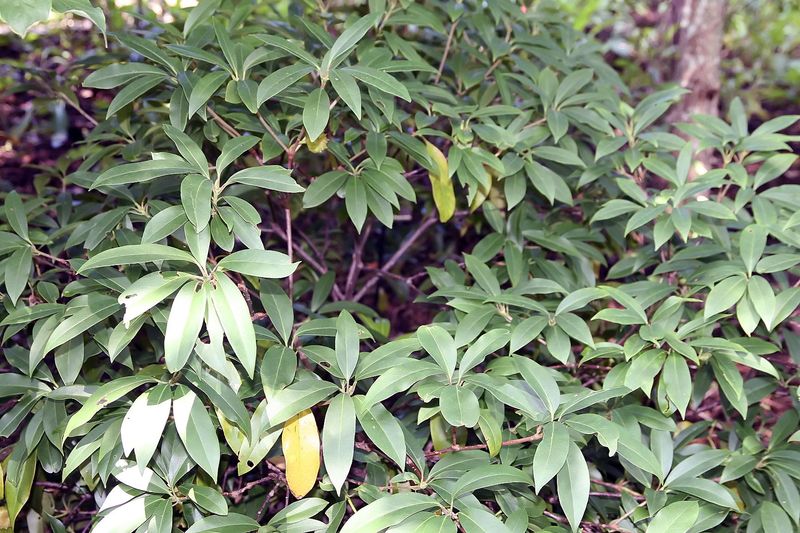
The Florida Anise Tree is a delightful evergreen shrub native to the southeastern United States, particularly in the rich understories of moist woodlands. Its lush, dark green leaves emit a sweet, spicy fragrance when bruised, reminiscent of star anise, lending it a special charm that captivates garden enthusiast and passerby alike.
This shrub typically grows in a layered structure, and its beautiful, star-shaped flowers bloom in the spring, showcasing shades of yellow to greenish-white that blend harmoniously with the surrounding foliage. The fruit, a cluster of interesting, elongated capsules, adds an appealing ornamental aspect to the plant and provides seeds for wildlife.
Florida Anise Trees thrive in shaded environments, making them an excellent choice for understory planting in larger gardens or woodland areas. Their adaptable nature, combined with their pleasing fragrance and visual appeal, ensures that they are a treasured addition to any native garden.
Inkberry (Ilex glabra)
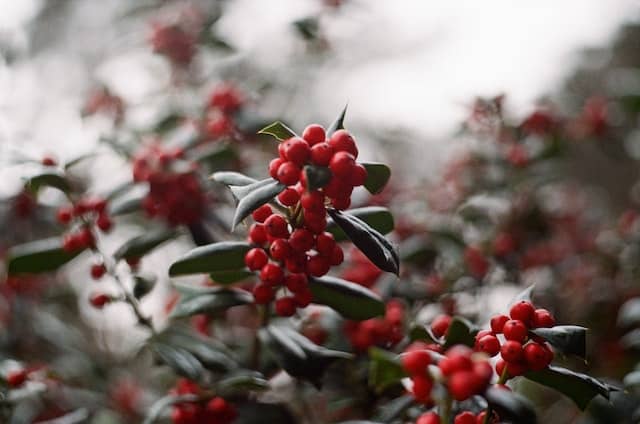
Inkberry is a remarkable native holly that stands tall and proud in the underbrush of eastern North America. Its dark green, glossy leaves and rounded shape make it an attractive option for both garden design and wildlife habitat. One of its most distinctive features is its ability to stay evergreen, offering a splash of life even in the dead of winter.
This shrub thrives in wet soils, often inhabiting swampy areas or damp woodlands, where its dense foliage provides crucial shelter for a variety of birds and small mammals. The black, glossy berries that appear in late summer are not only a feast for wildlife but also present an eye-catching contrast against the vibrant greenery.
Inkberry is also favorably used in landscaping due to its adaptability to various soil types and its relatively low maintenance requirements. Its dense growth habit allows it to act as a natural screen or hedge, providing privacy while encouraging biodiversity in the garden.
Kinnikinnick (Arctostaphylos uva-ursi)
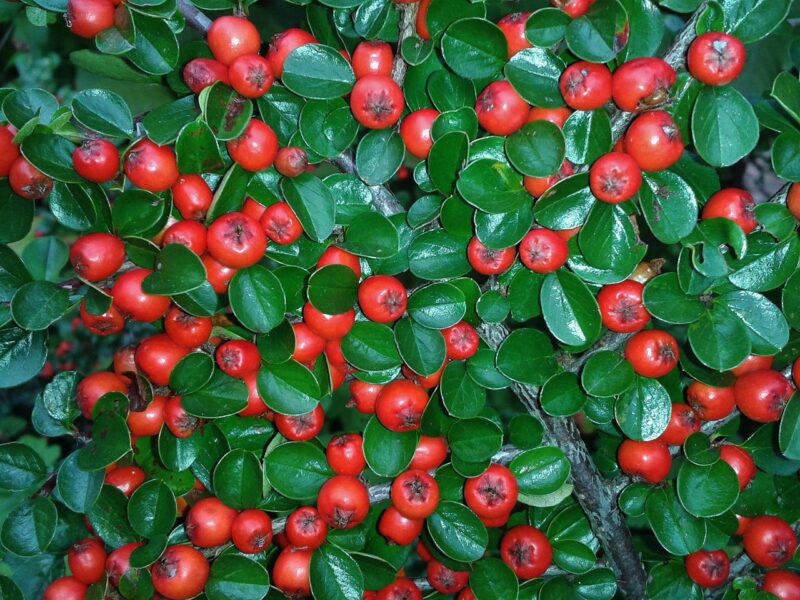
Kinnikinnick, or Bearberry, is a charming evergreen ground cover that brings a nuanced beauty to the landscapes of North America. With its trailing branches and leathery leaves, Kinnikinnick thrives in rocky, sandy soils, often seen in coastal regions, alpine conditions, and as part of mountainous forests.
The plant produces small, white to pink bell-shaped flowers in spring, which give way to bright red berries in the summer. Not only do the berries offer food for wildlife, but they also add a pop of color to your outdoor space. The leaves of Kinnikinnick are historically used by various Indigenous peoples for smoking or brewing, reflecting a rich cultural heritage linked to this resilient plant.
This evergreen shrub is particularly useful for erosion control and as a drought-tolerant ground cover in garden designs. Its adaptability to harsh environments and attractive characteristics make Kinnikinnick a valuable addition to any native plant garden, encouraging a sense of natural beauty and heritage.
Mountain Doghobble (Leucothoe fontanesiana)

Mountain Doghobble is a unique native evergreen that brings a distinct aesthetic appeal to gardens and landscapes throughout the southeastern United States. Commonly found in the understory of hardwood forests, this shrub possesses lush, elongated leaves that tend to droop gracefully, hence the moniker “doghobble.”
In spring, the Mountain Doghobble surprises us with stunning clusters of bell-shaped, creamy white flowers that dangle decoratively from the branches. These fragrant blooms attract various pollinators, including bees and butterflies, providing essential support to ecosystems.
Mountain Doghobble flourishes in damp, acidic soils, making it an ideal addition to woodland gardens or shaded borders. Its dense foliage offers refuge for small animals and birds, contributing to increased biodiversity in native landscapes. With its ornamental qualities and ecological contributions, Mountain Doghobble deserves a cherished place in any native plant collection.
Mountain Laurel (Kalmia latifolia)
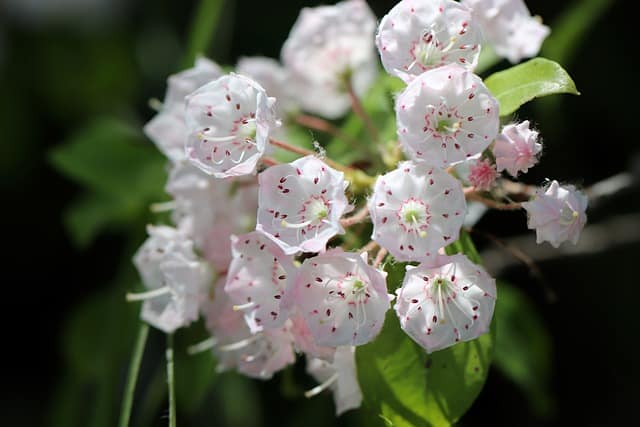
Mountain Laurel, a stunning native evergreen shrub, graces the forests of the Appalachian Mountains and regions of the northeastern United States with its dazzling, showy flowers. Known for its exquisite blooms that range from white to deep pink, Mountain Laurel becomes a veritable spectacle from late spring to early summer, attracting both pollinators and garden admirers.
This plant thrives in acidic soil and is often found in the understory of mountainous regions, where its flexibility in adapting to varying light conditions allows it to flourish. The alternate, leathery leaves provide a lush, green backdrop that enhances the beauty of the flowers, ensuring year-round appeal.
Caring for Mountain Laurel can be rewarding, as it is relatively low maintenance once established. It encourages diverse ecosystems, providing food and habitat for numerous bird species while showcasing its beauty in your garden. Its cultural significance also resides in its historical use by indigenous people for crafting and medicinal purposes, further lending it an air of respect and reverence.
Oregon Grape (Mahonia aquifolium)
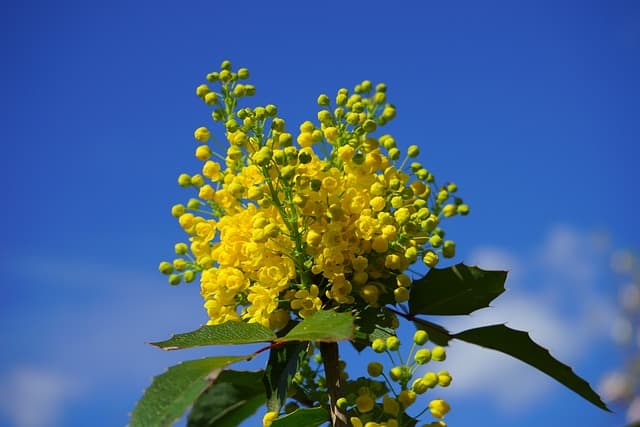
Oregon Grape is a versatile and colorful native evergreen shrub found primarily in the Pacific Northwest. Distinguished by its holly-like leaves and bright yellow flowers that bloom in spring, this plant offers a delightful sensory experience that beckons butterflies and bees into your garden during its growing season.
The deep blue to purple berries that follow the blooms in late summer add visual appeal while also serving as a food source for various animals. The jagged leaf margins provide a unique texture that enhances landscape designs and draws interest year-round.
Oregon Grape thrives in a range of conditions, demonstrating adaptability to both sun and shade. Its ability to enrich the undergrowth of forests while providing essential nutrients to the soil makes it an ecological treasure. Beyond its ornamental qualities, it has historically found applications in traditional medicine, and its vibrant berries can be transformed into jellies and sauces, showcasing the balance of beauty, function, and cultural significance.
Sparkleberry (Vaccinium arboretum)
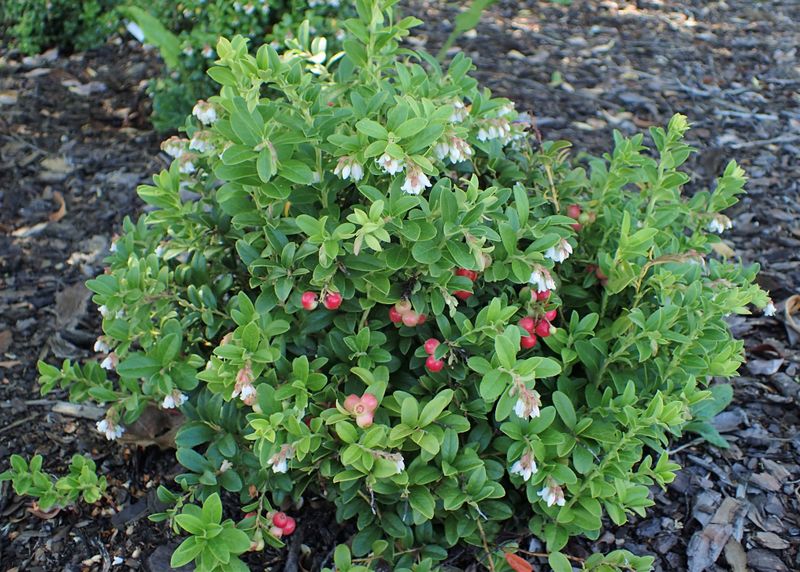
Sparkleberry, a native shrub to the southeastern United States, is recognized for its exquisite seasonal changes, adding layers of charm to any garden. This evergreen offers glossy foliage, with enchanting white flowers in spring that transform into vibrant red berries by late summer and autumn.
These berries serve as an essential food source for a plethora of birds and small mammals, ensuring the shrub plays a vital role in sustaining local wildlife. Sparkleberry thrives in a variety of climates, adapting to both wetland and more drier soils, thereby enhancing its landscape versatility.
In addition to being aesthetically pleasing, Sparkleberry contributes to soil health and stability, promoting ecological diversity. It serves as a fantastic choice for natural gardens, where wildlife conservation and native aesthetics merge seamlessly, providing an inviting environment for both flora and fauna.
St. John’s Wort (Hypericum spp.)
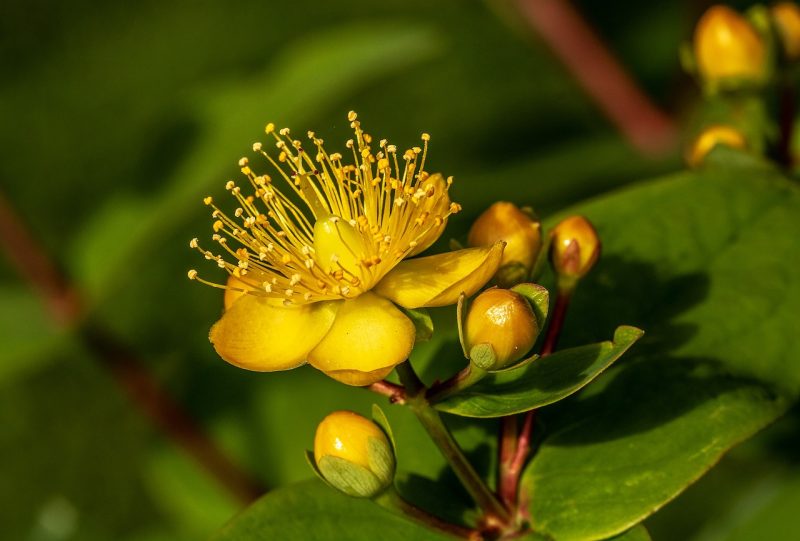
While many people know St. John’s Wort primarily for its herbal uses, this native evergreen shrub makes a valuable addition to gardens and ecosystems alike. Boasting vibrant yellow flowers in summer, it thrives in preferring well-drained soils and sunny locations, attracting numerous pollinators into the landscape.
St. John’s Wort has a rich history of medicinal usage, often employed as a remedy for various ailments, ranging from mood enhancement to anti-inflammatory properties. This cultural significance contributes depth to its nature as a garden plant, emphasizing the intertwined relationship between plants and human wellness.
Ecologically, the dense growth habit of St. John’s Wort provides cover and food for wildlife, underlining its importance in a native landscape. From its vibrant flowers to its medicinal heritage, St. John’s Wort captivates the heart and senses, embodying a multifaceted element in the world of native evergreens.
Sweet Bay Magnolia (Magnolia virginiana)

Sweet Bay Magnolia, a true beauty of the southeastern U.S., captures attention with its aromatic blossoms and glossy foliage. This evergreen tree offers not just stunning visual appeal but also a rich, sweet fragrance that permeates the landscape, creating a sensory experience that enchants everyone who encounters it.
Typically growing near coastal areas and wetlands, this elegant magnolia thrives in well-drained soils, tolerating both wet and dry conditions. The creamy white flowers bloom in late spring, drawing pollinators from afar, while the attractive foliage remains lush and green throughout the year.
The sweet, spice-like scent of the flowers is often likened to the depths of a tranquil forest in full bloom. Its significant contributions to soil stabilization and habitat making it a top choice for those invested in conservation and native landscaping. Beyond its ecological benefits, Sweet Bay Magnolia serves as an iconic culture symbol and an unparalleled choice for enhancing beauty and biodiversity in any garden setting.
Wax Myrtle (Morella cerifera)

Wax Myrtle stands as a resilient native evergreen shrub, adapting seamlessly to a multitude of environments, particularly in coastal areas of the southeastern United States. Renowned for its aromatic, evergreen leaves and dense, bushy growth, this shrub provides essential contributions to dynamic ecosystems.
The small, waxy berries that appear in late summer serve as a food source for numerous bird species, promoting a flourishing avian community. Its adaptability to various soil types and moisture levels makes it suitable for a diverse range of landscapes, from coastal dunes to riparian zones.
Wax Myrtle is also appreciated for its practical uses, with its leaves historically used in traditional medicine and culinary applications. The plant’s fragrant properties can repel insects, making it a valuable organic pest deterrent in landscapes. With its combination of ecological roles, aesthetic contributions, and practical benefits, Wax Myrtle is a worthy consideration for any native garden enthusiast.
Yaupon Holly (Ilex vomitoria)
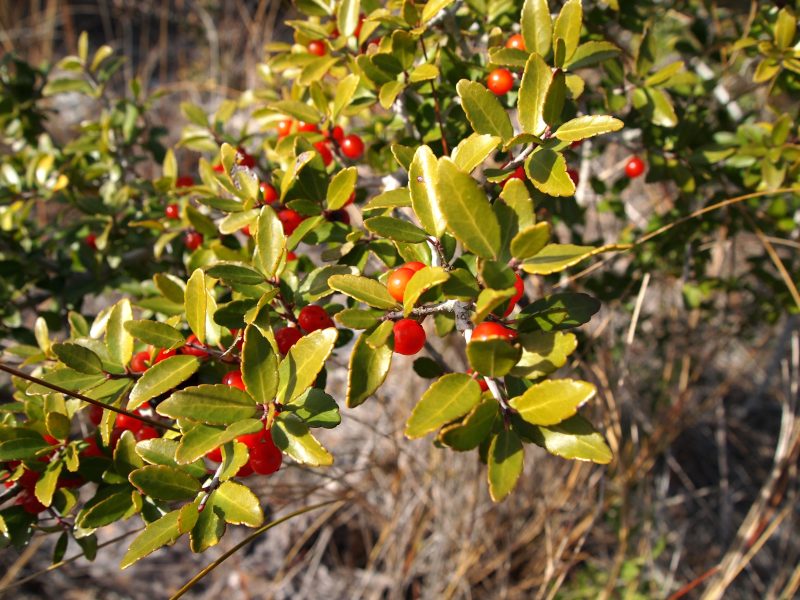
Yaupon Holly is an iconic native evergreen shrub that thrives in the southeastern United States, characterized by its glossy green leaves and bright red berries. This versatile plant has a robust growth habit, making it an exceptional choice for hedges, screens, or simply as an aesthetic element in landscape design.
The berries of Yaupon Holly are an important food source for various wildlife, from birds to small mammals, supporting thriving ecosystems. In addition, the leaves of this shrub contain caffeine and have a rich history of use among indigenous peoples, who brewed them into a stimulating tea.
Yaupon Holly is highly resilient, tolerant of a range of soil conditions, and adept at handling salt spray, making it an excellent choice for coastal gardens. Its vibrant color and adaptability to the environment further enhance its appeal, reminding us of the integral role that native evergreens play in enriching our landscapes and preserving local heritage.
Conclusion
The world of native evergreens is as diverse as it is beautiful, offering myriad options for enhancing landscapes and fostering ecological health. Each plant contributes uniquely to its environment, providing food, shelter, and aesthetic beauty. By embracing native evergreens such as California Bay, Carolina Rhododendron, or Yaupon Holly, we not only enhance our gardens but also help preserve the critical ecosystems that support our local wildlife.





